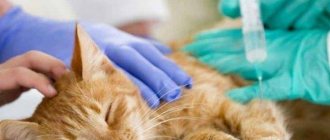For many animal lovers, a cat is a full member of the family. And, naturally, every owner wants his pet to live as long as possible, to be healthy and active. But animals do not always live to a ripe old age and die quietly without suffering. It happens that a pet becomes seriously ill, suffers from pain and cannot be cured. In this case, most veterinarians advise euthanasia. Therefore, this article will discuss the following pressing issues: how to euthanize cats at home, how does this process take place in a veterinary clinic, and how much does euthanasia cost? You can read the article “The most common cat diseases: symptoms and treatment.”
Indications for euthanasia of an animal
Euthanasia is a medical cessation of all vital functions that is painless for the animal. This extreme measure is resorted to, trying to minimize suffering and pain in case of incurable diseases.
The question of when to euthanize a cat is decided individually by everyone. There is no need to draw hasty conclusions here, but there is often no need to hesitate either. A qualified veterinarian, after a full examination and assessment of the prospects, makes a recommendation for euthanasia. In 90% of cases, such a recommendation is worth listening to - the only exceptions are situations where the diagnosis was clearly made hastily or you have reasonable doubts about the veterinarian’s qualifications.
There are several ethical reasons for euthanizing a cat:
- Receiving injuries incompatible with life. In this case, euthanasia is the end of the body's agony, which would otherwise last for several hours or even days. Healthy cats have enviable vitality, but sometimes this quality “plays against them”, prolonging unnecessary suffering.
- Incurable diseases. We are not talking about all diseases, but only about those that disrupt vital functions and thereby cause severe suffering to the cat. Reasons for euthanasia may include severe pain, internal bleeding and other symptoms.
- Advanced age. There is no point in simply euthanizing a cat that has aged. You can only think about this procedure when the animal is unable to care for itself. Over time, many vital functions begin to weaken, and if the cat cannot move on its own, eat food or perform natural needs, the question of euthanasia can be raised.
How to euthanize a cat without a veterinarian?
Cats are considered one of the most loving and inspiring animals in the entire world. This is a beautiful animal, which is considered throughout the world a symbol of love and peace.
But one day everything will come to an end, and all we can do is to make it as painless as possible. When your cat has been a part of your life for so many years, it's not easy to say goodbye.
But when you notice that your cat is no longer enjoying her life or is suffering from a variety of health problems, or she doesn't have the energy to stand on her own and she can't defend herself. This is a good time to say goodbye to both you and your cat.
© shutterstock
One of the main causes of such problems is aging, and an overgrown cat cannot survive on its own. And when you see a crying cat, it means that he is giving you a signal that the time has come.
In such circumstances, rather than making any emotional decision, it is better to consult a veterinarian. He will guide you; what to do and how to do it. The final decision will be yours whether you want to euthanize your cat at home or take her to the veterinarian's office.
You can say goodbye to your cat at home. And after that, you can euthanize him/her or let the vet do it for you.
The veterinarian primarily uses euthanasia, and this can cost you a serious amount of money. If you can afford it, you can let the vet put your cat to sleep, but if you can't, it's best to use home methods and do it yourself.
When should a cat not be euthanized?
In addition to the ethical reasons for euthanizing a cat, there are other arguments. They are sometimes brought in not only by animal owners, but also by unscrupulous veterinarians. Here are just a few of them:
- Bad behavior (damage to things, “tags” in the wrong places).
- Aggression towards owners, their children, and other pets.
- Loss of external attractiveness due to old age.
- An illness or injury that requires long-term, costly treatment.
In none of these cases is there a real need for euthanasia. Therefore, the vast majority of veterinarians will refuse the offer to carry out the procedure. And this refusal will be completely fair.
How much does euthanasia cost?
The cost of euthanasia may vary between veterinary hospitals. It all depends on the organization itself and on the drugs used. Affects the price and location of the hospital and the size of the city. In a small city, euthanasia will cost 30% less than in a large metropolis.
Without a specialist visiting your home, euthanasia will cost a little less. Since you will have to pay about 1000-1500 rubles for a doctor’s visit. Also, the price of euthanizing cats without pain also depends on the size of the pet. Many clinics cooperate with funeral agencies. Therefore, in addition to euthanasia itself, additional services such as disposal or cremation may be offered. Also, the ashes of the animal can be returned in a special vessel at the client’s request. Such a service will cost much more than regular cremation.
Whether to cremate a pet or choose a regular burial depends on the wishes of the owner and his financial capabilities.
On average, euthanizing a cat costs from 1000 to 2000 rubles. Euthanasia with a veterinarian visiting your home costs approximately 3,000 rubles. Some clinics offer euthanasia of cats at home inexpensively - for only 1,300 rubles. But you shouldn't chase a low price. The most important thing is the professionalism of the doctor. Therefore, it is advisable to consult with friends and acquaintances about choosing a good clinic. The average price for cremation of a body is 1000-4000 rubles. Removing the body for cremation costs about 1000-3000 rubles.
Euthanasia procedure: technical and ethical aspects
Some pet owners prefer not to euthanize their cats, but to let them die on their own. Yes, psychologically such a death is easier to bear (it gives the impression of being natural), but such a decision almost inevitably dooms the animal to prolonged suffering.
When carrying out euthanasia, a drug for anesthesia is injected into the cat's body - but in a dose significantly higher than the recommended one. As a result, the cat simply falls asleep, after which brain death occurs due to lack of oxygen. For some time, cardiac activity still persists - but it either fades out on its own, or after brain death is determined, it is stopped by injection of a special drug.
This technique eliminates any painful sensations, therefore euthanasia of a cat should be considered as an act of humanity and the last service of the owner to the pet, which for many years has delighted people with its presence.
How to decide on euthanasia?
Deciding to euthanasia is always difficult, because with his decision the owner ends the life of a pet, and not everyone is capable of taking on such responsibility. You need to make sure that the diagnosis is correct. If there is even the slightest doubt, it is advisable to contact several specialists - the possibility of a medical error always exists. Another veterinarian may be able to suggest a treatment option that offers a chance of recovery or at least improvement.
If experts are unanimous, the pet can no longer be helped and is experiencing terrible suffering, euthanasia is a humane way to alleviate its fate. If a veterinarian advises euthanizing a cat, it means that its death is inevitable, and therefore helping it pass away easily and painlessly is the right decision.
Types of tranquilizers and their effects
In the previous section, we already said that sleeping pills are divided into three groups based on the duration of their effect. Let us describe these groups in more detail.
Short term
After taking them, the cat will sleep for 2-3 hours, most often used for transportation, with increased excitability, stress or sleep disorders.
The most effective drugs in this group:
- Xylanite . Available in the form of a solution for injection. Externally it appears as a colorless or light yellow liquid. Has a calming effect on small pets for 1.5 – 2 hours. It also acts as a pain reliever - in this case it acts for 15-30 minutes. The effect occurs on average after half an hour. Xlanit is administered intramuscularly to cats. The dosage is calculated at 0.15 ml per kg of animal weight.
- Intraval . Puts the cat to sleep for no longer than a quarter of an hour. In case of sleep disturbances, it increases its duration. Also used for convulsive seizures. It is introduced into the body intravenously.
- Barbamil . The drug is indicated for surgical interventions or severe stress. It is given to the cat orally. It is advisable to mix the medicine with a treat for the animal. Before use, consultation with a veterinarian is necessary, since the medicine has a number of contraindications.
Medium term
The animal goes to sleep for 4-5 hours. Prescribed for the treatment of serious mental disorders, severe seizures, and also for preparing a cat for sleep.
- Etaminal sodium . The drug is considered harmless to cats, non-toxic. Copes with nervous excitement and stress. The product is addictive, so it should be used with caution.
- Barbital sodium . The animal falls asleep 1.5 hours after administration. The drug is completely eliminated from the body after 10 hours.
- Chloral hydrate . The drug should not be taken by pregnant or lactating cats, as well as pets under six months of age. The drug has an even larger list of contraindications, so its use should begin after consultation with a veterinarian and under his constant supervision.
Long-term
The drugs induce the cat to sleep for 10 hours and are used only during surgical interventions. The drugs are available only by prescription and are used under the supervision of a veterinarian. When using, the dosage must be strictly observed, otherwise the animal may not wake up after sleeping pills.
- Ketamine . In addition to the main effect - a sleeping pill - the drug has an effect on the cardiovascular system: it stimulates the heart, increasing the heart rate and increasing blood pressure. It is administered intramuscularly and intravenously. The medicine should not be used for animals prone to seizures, as well as for procedures that can provoke seizures.
- Ftorotan . It is introduced into the animal's body by inhalation. It must be used with extreme caution, since the wrong dosage can lead to complete cardiac arrest. Anesthesia occurs quickly, without a phase of motor excitation. At the same time, the animal recovers from anesthesia just as quickly.
- Methoxyflurane. The drug is also administered by inhalation. The effect of the drug takes quite a long time, since its components are easily dissolved in lipids. It is used most often when not only a hypnotic effect is needed, but also an analgesic effect.
Important! Medium- and long-term groups of drugs can only be used for a short period, as they are highly addictive.
Sleeping pills are available in tablet form, but are extremely rare. Most often, the medicine is produced in the form of drops or liquid for the preparation of a solution for injection.
Attention! Drugs intended for humans are not suitable for animals, since the concentration of active substances in them is increased by 10-15 times.
What's next?
After euthanasia, the owner once again has to make a choice:
- keep the body for self-burying
- leaving him at the clinic or veterinarian for cremation and further burial is the most common option
- leave for cremation with return of ashes
Cremation is usually common for many animals, in which case you cannot be sure that the ashes returned to you will be those of your pet.
Currently, organizations have emerged that provide funeral services for pets, including: painless euthanasia of the animal, general and individual cremation in the presence of the owner, video recording, distribution of ashes after individual cremation in a special urn, etc.
Some large cities also have official pet cemeteries. Alas, not in all of them.
In the civilized world, the problem of burial has long been solved. Almost every European city has an animal cemetery. There are about 650 specialized burial sites in the United States. The most expensive one, on which the dogs of Charlie Chaplin, Steven Spielberg and other celebrities rest, is located in Los Angeles.
What is the procedure like at a veterinary clinic?
Euthanasia of a cat in a veterinary clinic is carried out in several stages:
- Signing by the owner of a consent to euthanize his pet, indicating the reason.
- Introducing the patient into anesthesia. After the sedative is administered, the animal falls into deep sleep. It continues to breathe, its heart beats, but the nervous system is switched off, it does not feel pain and does not react to external stimuli. At this stage, you usually say goodbye to your pet.
- Administration of drugs leading to blocking of the respiratory center and cardiac arrest. For humanitarian reasons, the owner is taken out of the office.
Some veterinary clinics administer a lethal injection without putting the animal into a narcotic sleep. This method is not the most humane, since the cat is conscious and experiencing suffering (feels pain, suffocation, panic). Before carrying out the procedure, you need to clarify how it is carried out in a particular clinic, and if necessary, insist on a preliminary introduction to anesthesia.
Why is it necessary to euthanize your pet at home yourself?
Sometimes owners decide not to contact a veterinarian, but to kill the animal with their own hands at home. Typically, this decision is explained by living in places remote from populated areas and the high cost of the procedure. Putting a pet to sleep at home, much less with your own hands, is not the best option for impressionable owners. This is morally difficult, and besides, the place where the cat passes away will remain a reminder of the loss for a long time, evoking difficult feelings and memories.
If visits to the clinic were regular and the cat treats them calmly, it is better to euthanize it in a hospital.
If an animal experiences extremely painful situations when it has to leave its home, it is better to let it die in a familiar environment, without subjecting it to additional stress from a trip to the clinic.
Treatment prices:
| Service | Price, rub) |
| Types of therapies | |
| Standard detoxification therapy | 3 500 ₽ |
| Double Detox Therapy | 6 000 ₽ |
| Enhanced Detoxification Therapy | 7 500 ₽ |
| Maximum detoxification therapy | 9 500 ₽ |
| Quick sobering up at home | 7 500 ₽ |
| Hospital at home 1 day | 22 000 ₽ |
| Advanced hospitalization | 15 000 ₽ |
| Treatment in hospital | |
| Accommodation | |
| Economy chamber (6 beds) | 2 000 ₽ |
| Standard room (4 beds) | 3 000 ₽ |
| Increased comfort (2 seater) | 5 500 ₽ |
| VIP chamber (1 person) | 12 500 ₽ |
| Individual post 24/7 | 5 000 ₽ |
| Medical and social rehabilitation 21 days | 140 000 ₽ |
| Service | Price, rub) |
| Initial consultation with a narcologist | for free |
| Consultation with a psychologist | 3 000 ₽ |
| Psychiatrist consultation | 5 000 ₽ |
| Coding at home Torpedo | 7 500 ₽ |
| Express output and encoding (doublet) | 13 500 ₽ |
| Coding using the Dovzhenko method | 12 000 ₽ |
| Hypnosis classic session | 13 000 ₽ |
| Ericksonian hypnosis session (NLP) | 8 000 ₽ |
| Coding method Torpedo | 5 500 ₽ |
| Double block | 8 000 ₽ |
| Esperal injection for 1 year | 9 900 ₽ |
| Tetlong for 3 months | 10 500 ₽ |
| Esperal gel for 1 year | 15 000 ₽ |
| Selincro course of therapy | 12 500 ₽ |
| Implantation of Disulfiram for 1 year | 18 000 ₽ |
| Vivitrol injection for 1 month | 26 000 ₽ |
| Naltrexone stitching for 3 months | 35 000 ₽ |
| Neuroimplantation Prodetoxon for 6 months | 47 500 ₽ |
| Narcopsychotherapy session | 50 000 ₽ |
| Neutralization of encoding | specify |
| Psychodiagnostics / pathological diagnostics | 7 500 ₽ |
| Psychotherapy session | 5 000 ₽ |
| Family psychotherapy | 6 000 ₽ |
| Outpatient rehabilitation in Moscow | 33 000 ₽ |
Expand
If necessary, the drug addict will undergo such measures as: incubation, catheterization, resuscitation, and so on.
All the efforts of our specialists are aimed at saving people from drug death.
Article verified by an expert
Terekhova Anna Vladimirovna
psychologist-consultant on socio-psychological work with addicted clients and their families. More than 10 years of experience.
Similar articles:
The danger of gambling addiction in teenagers
Why doesn't rehabilitation work?
Alcoholism and drug addiction. Resistance to treatment
Alcohol intoxication
Is TRIGAN-D a drug?
One comment on “Drug poisoning: first aid”
- Karina:
June 21, 2021 at 03:53
First aid for poisoning by any substance that has entered the body through the mouth is to rinse the stomach and intestines and take adsorbents that accelerate the removal of toxins from the body.
Answer
Temporary euthanization of a pet
This type of euthanasia is used if, for example, hygiene procedures are required. Veterinarians do not recommend using strong anesthetics or barbiturates for this purpose, because this is dangerous. In case of even the smallest overdose, the animal can die. It is better to give preference to sedatives that are available without a prescription. These include Stop-Stress, Cat-Bayun and others. Propofol, Vetranquil and Rothemar are used by veterinarians, but cat owners are better off not touching them so as not to harm the pet.











